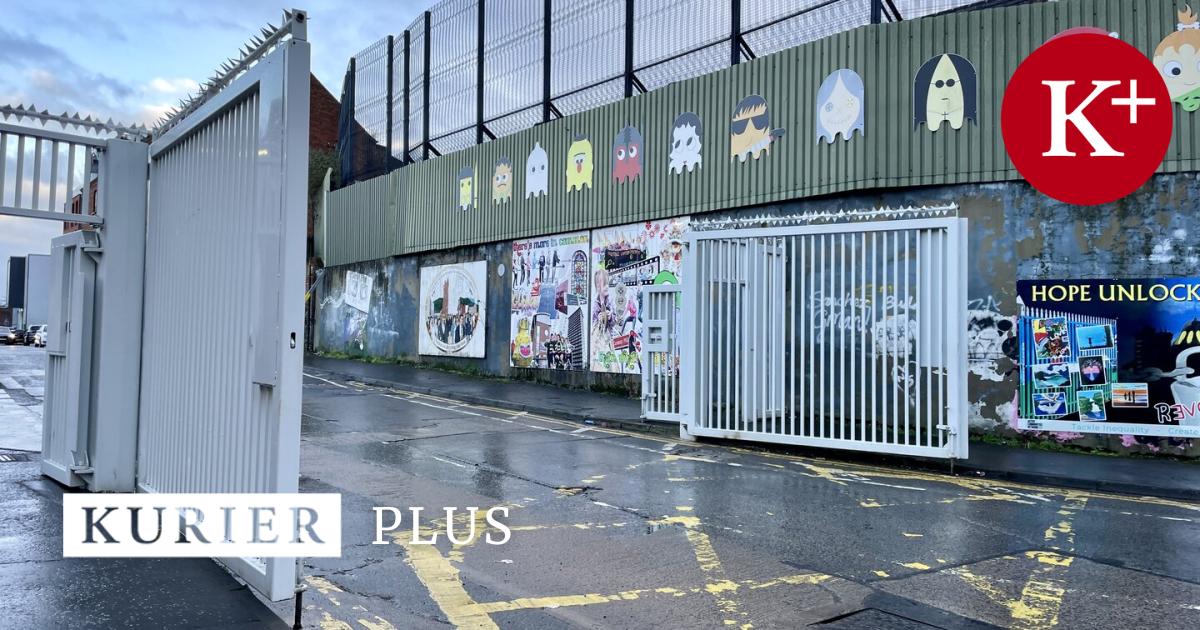Jim White was 14 years old when he lost his best friend. Not because he moved away or because they had an argument. But because there was suddenly an eight meter high wall. Which separated the Protestant north from the Catholic west of Belfast. And so Jim White from his best friend.
Today, at 69, Jim White can revisit the once notorious Catholic Springfield Road in west Belfast. Not if he doesn’t have to. But it works. “A lot has changed,” says the 69-year-old when the KURIER meets him while walking along the wall. “The troubles are over.”
And yet he likes the fact that the Peace Wall gate on North Howard Street will be closed overnight.
“Otherwise someone will come up with stupid ideas.” Because even if the 30-year conflict was settled with the Good Friday Agreement in 1998, there is no trust in calm. And so perhaps a few more measures are needed at the moment, a few crutches.
The anger of the unheard
500 meters and a wall away from Jim White, Michael Culbert sits at a wooden desk and works on a different form of processing. With his association Coiste he offers political tours along the Peace Wall. He took around 16,000 people to central points in Belfast and in the history of the paramilitary. “We’re not objective,” Culbert admits. That’s not what he’s interested in, but rather about making things visible and standing up for politically condemned people.
Convicts like himself. Culbert was 23 years old when he joined the IRA, the Irish Republican Army – mobilized by the events of Bloody Sunday.
On January 30, 1972, the British army shot and killed 13 Irish nationalists during a demonstration in the Northern Irish city of Derry/Londonderry. That day it became clear to Culbert: the reform he, like so many, demanded was not going to come. No end to religious discrimination, as he describes. No change to the voting law, which at the time only allowed (mainly Protestant) homeowners to vote.
“If reform is not given to you,” Culbert says in a clear voice and his gentle eyes harden for a moment, “you have to take up arms.” He adds: “I was a social worker, married, had two children. My wife was a teacher. If someone like me joins (the IRA, note), doesn’t that say it all?”
The scars of the conflict
“Bloody Sunday” was the spark in the powder keg in the Northern Ireland conflict. While 200 people died in attacks and unrest on both sides in the previous three years, 479 died in the twelve months afterward. To protect the neutral city center, a ring of steel was drawn.
“Here,” says tour guide James Ellison, pointing to round holes on the wall between the bank and the greeting card shop. “The fence was anchored to the house.” You had to lean against the wall like a starfish, arms and legs wide apart, Ellison remembers. Was patted down before being allowed into the center. Was that scary? Ellison shrugs. “You get used to everything.” And actually the control made it safer.
Go on. In two and a half hours, Ellison takes tourists to the conflict hotspots of Belfast city center on the “Dead Center Tour”. It leads approximately to 7 Castle Lane, where the Abercorn Restaurant was once located. In which two girls ordered a coffee on March 4, 1972 and would never drink it. They left the restaurant, but left a backpack behind. 130 people were injured in the explosion and two were killed. Today the fan shop of an English football club is located here.
The success of tourism
He takes the group to 35 Hill Street, where Terri Hooley’s Harp Bar not only brought life to the deserted city center, but also created a place where young Protestants could celebrate together alongside Catholics.
While visitors from America, Spain and Italy listen to Ellison’s anecdotes, shoppers rush past the group and the laughter of school groups echoes through the streets. Despite, or perhaps because of, its dark legacy, tourism in Belfast has developed into an industry worth more than a billion euros since 1998. But: “Peace is fragile,” says James Ellison at the end of the tour.
How quickly anger can resurface was shown in April 2021, when petrol bombs were detonated, police officers were attacked and a bus was set on fire. A reaction to Brexit. While the Catholic Republicans fear a hard border between Ireland and Northern Ireland as a result of England’s exit from the EU (even though this was set out in the Good Friday Agreement), the Protestant Unionists worry about being separated from Great Britain by border controls at sea.
The opening of the boys
The next generation is still looking forward. Like so many young Belfast people, 32-year-old Gemma Gabbie, who is walking around the city center with her daughter, is not interested in politics. “The Good Friday Agreement served its purpose.”
A group of young people is even fighting for the Gates of Peace to be opened for a longer period of time – initially for a few hours, and eventually forever. “I know,” 18-year-old Katie-Louise from the Protestant Shankill Road told the BBC, “that a lot of people felt that the gates were necessary to protect them.” But, adds Nadia from the Catholic West Belfast: “I think that the gates and walls already create the stigma that we shouldn’t like the people on the other side.”
A peace wall should not separate best friends.
